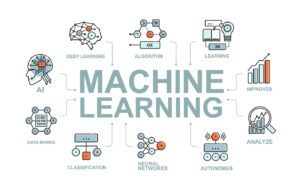Introduction:
A type of artificial intelligence called machine learning enables computers to learn from experience and get better as time passes, just like people do. It involves developing algorithms and models that enable systems to automatically discover patterns, make decisions, and improve based on data inputs over time.

How Does Machine Learning Work?
Supervised Learning:
In supervised learning, algorithms are trained on labeled data, where the correct answer is provided. The algorithm learns to make predictions by identifying patterns in the training data and then applying those patterns to new, unlabeled data.
Unsupervised Learning:
Unsupervised learning involves training algorithms on unlabeled data, where the system discovers patterns and relationships independently. This can include clustering similar data points or reducing the dimensionality of the data for a more straightforward analysis.
Reinforcement Learning:
Reinforcement learning is inspired by behavioral psychology, where an algorithm learns through trial and error. It interacts with an environment, receives feedback through rewards or penalties, and adjusts its actions to maximize the rewards.
Applications of Machine Analysis/Learning:
Fraud Detection:
Financial institutions rely on machine learning to detect fraudulent activities. By learning patterns from historical data, algorithms can identify suspicious transactions and prevent potential fraud, bolstering the security of financial systems.
Bias and Fairness:
Machine research models can inadvertently learn biases in the training data, leading to biased decisions. Addressing and mitigating bias is critical to ensuring fairness in AI-driven systems.
Financial Forecasting:
Financial institutions harness the power of machine analysis for accurate market predictions and risk assessment. Algorithms process vast amounts of financial data in real time, enabling traders to make informed decisions. Additionally, fraud detection algorithms help prevent unauthorized transactions, safeguarding businesses and consumers.
Autonomous Vehicles:
The automotive industry is rapidly moving towards autonomous vehicles, and machine learning is pivotal in enabling these cars to navigate safely. These vehicles rely on advanced algorithms to interpret data from sensors and cameras, making real-time decisions to ensure passenger safety.
Healthcare Revolution:
Machine testing transforms healthcare by revolutionizing diagnostics, treatment plans, and drug discovery. Algorithms can accurately analyze medical images, aiding in early disease detection. Moreover, personalized treatment plans can be developed by analyzing patient data, leading to improved outcomes and reduced costs.
Personalized Marketing:
In marketing, machine learning facilitates personalized campaigns by analyzing consumer behavior and preferences. This technology enables businesses to tailor their offerings to individual customers, enhancing engagement and conversion rates.
Education Enhancement:
It is reshaping education through personalized learning experiences. Algorithms adapt learning materials to individual students’ progress and learning styles, fostering more effective and engaging educational journeys.
Image and Video Analysis:
Machine research/learning algorithms excel at analyzing images and videos. They can identify objects, detect anomalies, and even generate captions, making them invaluable in surveillance, content moderation, and creative arts.
Robotics and Automation:
Robots with machine analysis capabilities are becoming essential in industries like manufacturing and logistics. These robots can learn tasks, adapt to changing environments, and collaborate with human workers to improve efficiency.
Challenges and Ethical Considerations
Environmental Monitoring:
Machine Research aids environmentalists in monitoring ecosystems and predicting natural disasters. By analyzing sensor data, algorithms can provide early warnings for events like earthquakes, enabling proactive measures to mitigate damage.
Data Privacy and Security:
As machine research/learning relies on vast amounts of data, concerns about data privacy and security arise. Striking a balance between data utilization and individual privacy is essential.
Entertainment and Gaming:
It transforms the entertainment industry by recommending personalized content to users. Streaming services and gaming platforms use algorithms to analyze user preferences and behavior, offering tailor-made suggestions and experiences.
Agricultural Advancements:
In agriculture, machine research optimizes crop yield and resource utilization. Sensors collect data on soil conditions, weather patterns, and plant health, allowing farmers to make data-driven decisions to maximize productivity.
Enhanced Customer Support:
Customer service experiences significant enhancement through machine analysis-powered chatbots. These bots provide instant responses, resolve common issues, and escalate complex problems to human agents, streamlining the support process.
Natural Language Processing (NLP):
The primary objective of NLP, a branch of machine research, is to make it possible for computers to comprehend, analyze, and produce human language. This technology powers virtual assistants like Siri and chatbots, providing seamless customer support and automating various tasks.
The Future of Machine Learning:
The future of machine research is promising, with advancements in deep learning, reinforcement learning, and neural networks. As technology evolves, machine research will continue revolutionizing industries, enhancing user experiences, and driving innovation.
Conclusion:
In conclusion, machine learning is a transformative technology that holds the potential to reshape industries, enhance decision-making, and improve human lives. Its wide-ranging applications, coupled with ongoing research and advancements, ensure that the journey of machine research is bound to yield remarkable achievements.
FAQs (Frequently Asked Questions)
How do machines learn from data?
Machines learn from data by identifying patterns, relationships, and correlations within the data. Algorithms use these insights to make predictions or decisions when presented with new, unseen data.
Difference between AI and machine learning?
The reproduction of human intelligence in computers is referred to as artificial intelligence (AI), a more general term. Machine research is a subset of AI that enables devices to learn from data and improve performance.
What are some popular machine-learning tools?
Popular machine research tools include Tensor Flow, Porch, sci-kit-learn, Kera’s, and Jupiter Notebook. These to machine research models.
Is machine Analysis only used in high-tech industries?
It has applications across various industries, including healthcare, finance, agriculture, entertainment, and more. Its versatility makes it a valuable tool for optimizing processes and making informed decisions.
Can machine learning algorithms outperform human intelligence?
While machine research and learning algorithms excel at specific tasks and can process vast amounts of data quickly, they still need to be expanded by the scope of their training data and the algorithms themselves. Human intelligence encompasses a broader understanding of context, creativity, and emotional nuances.

